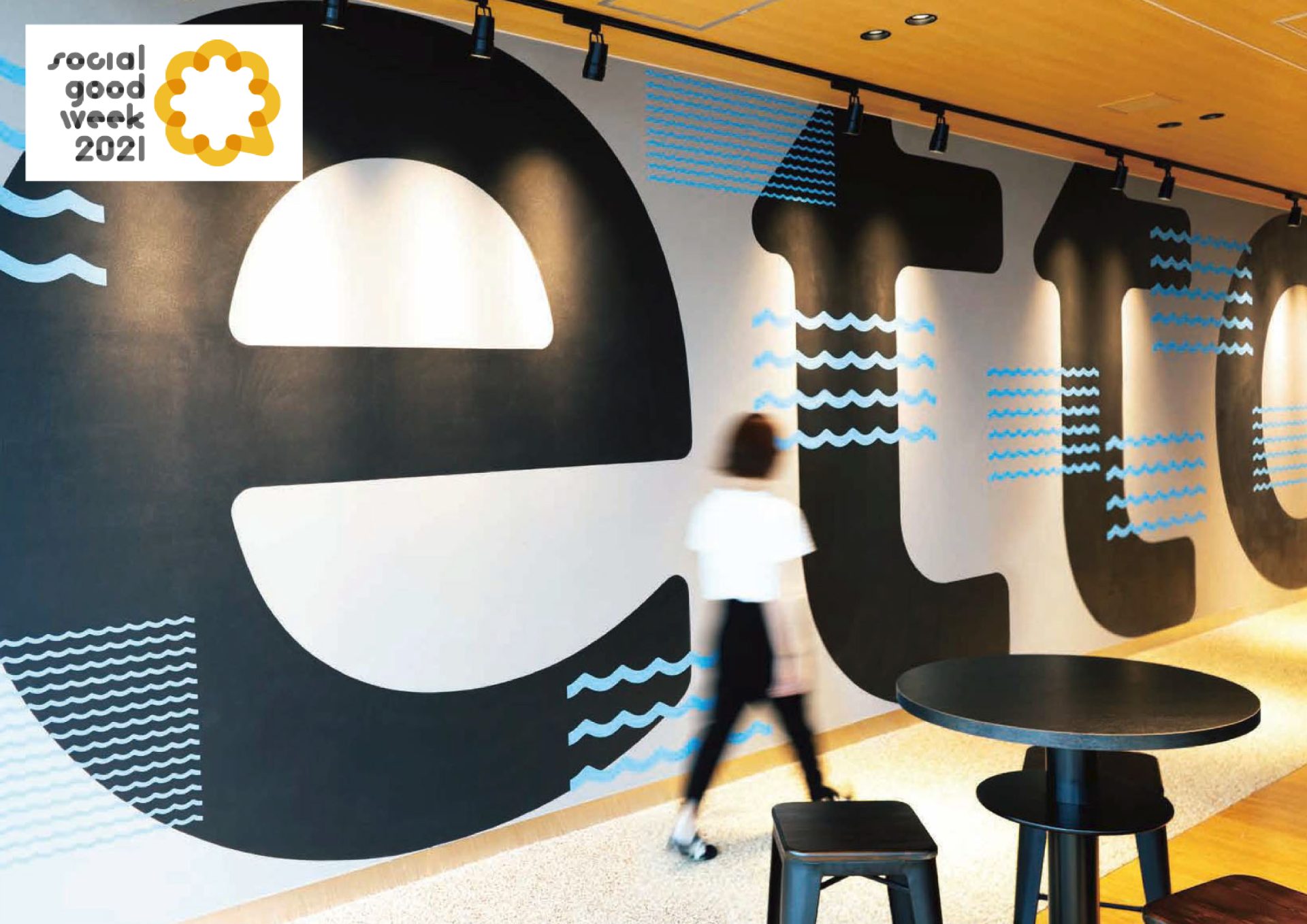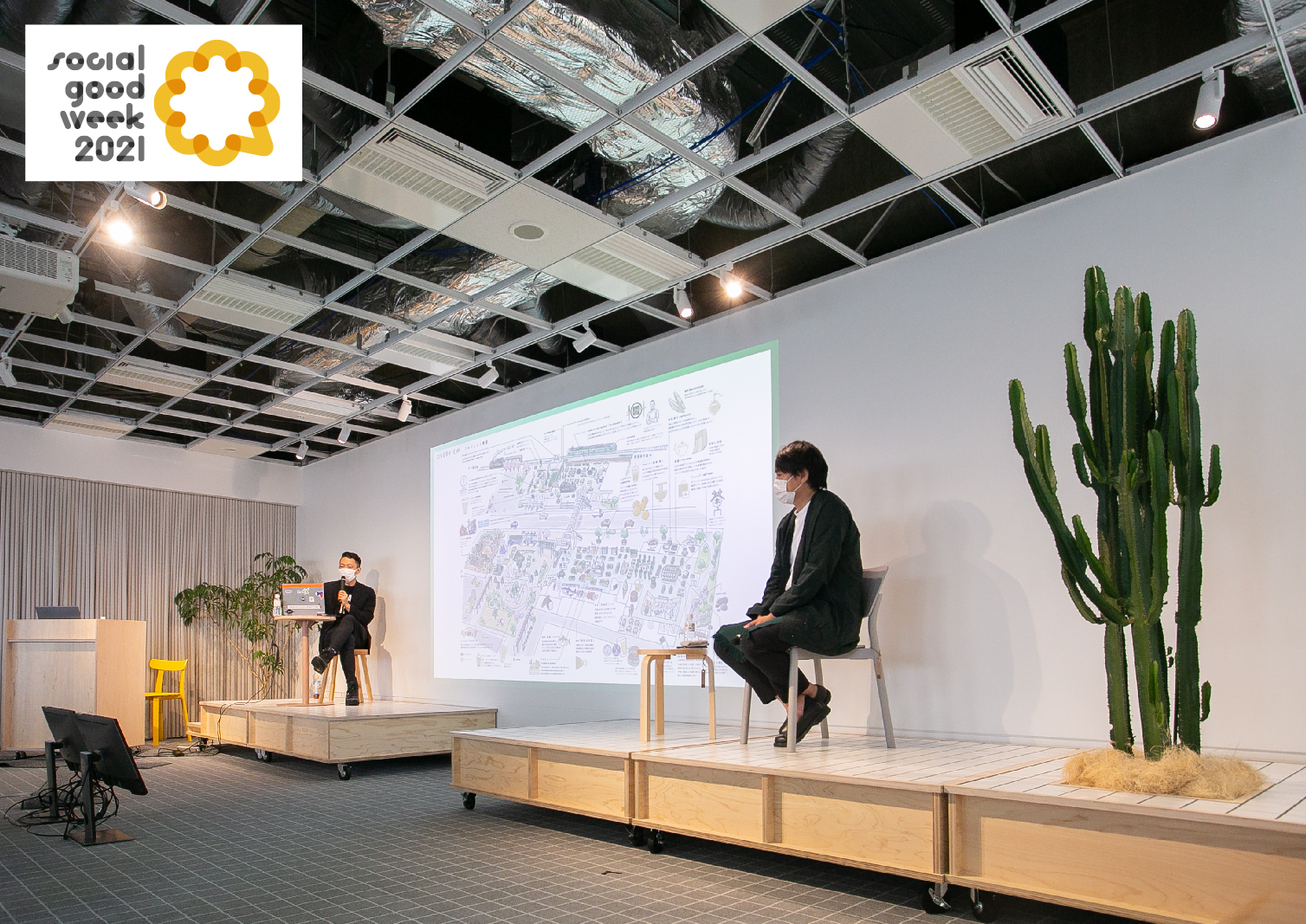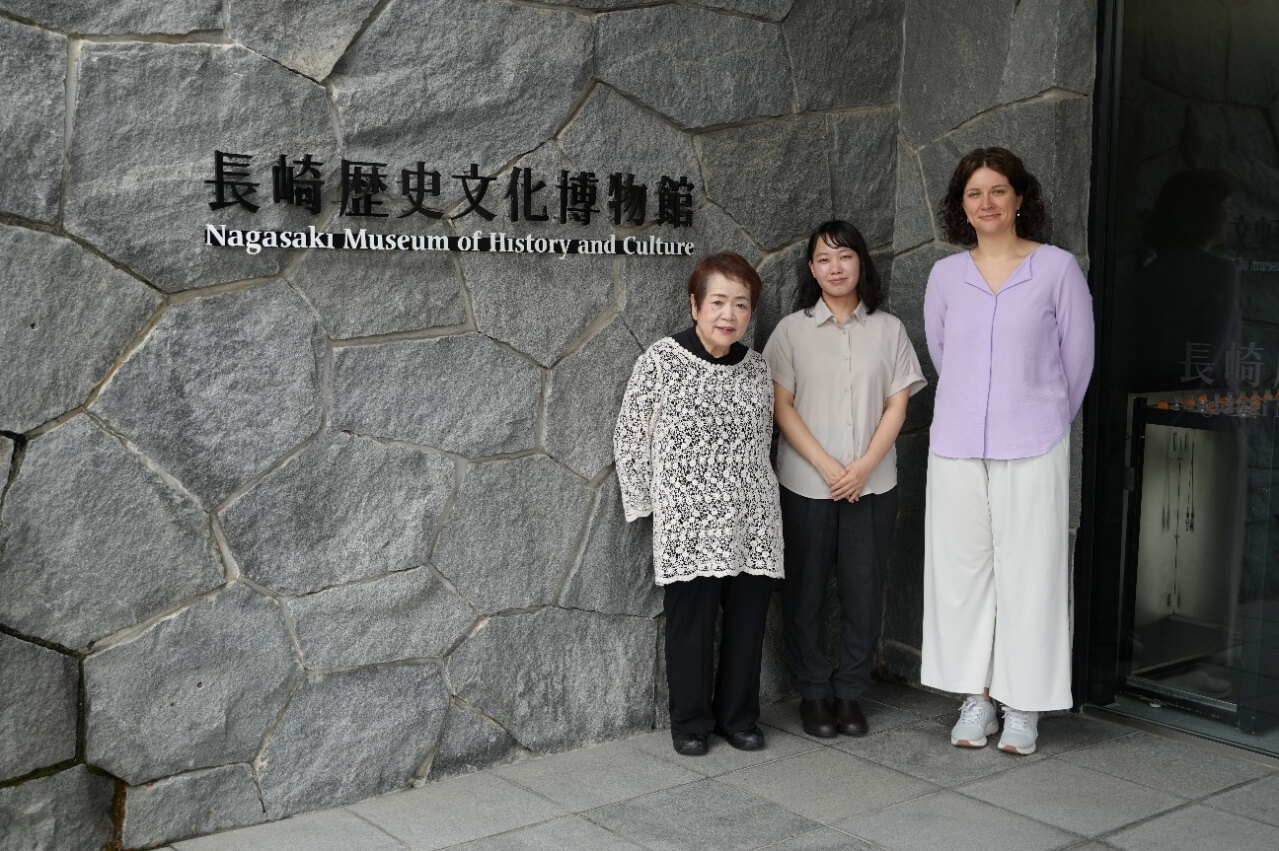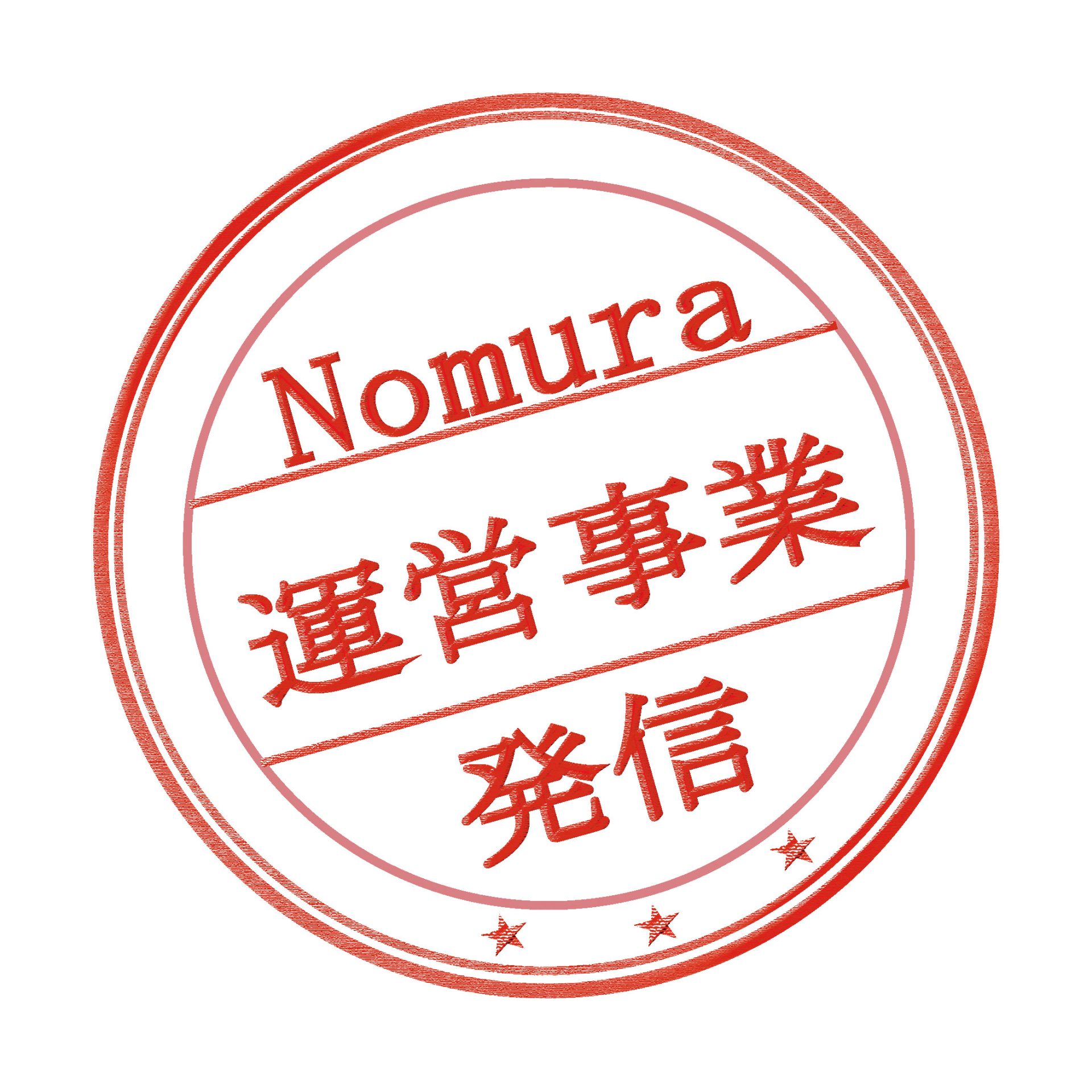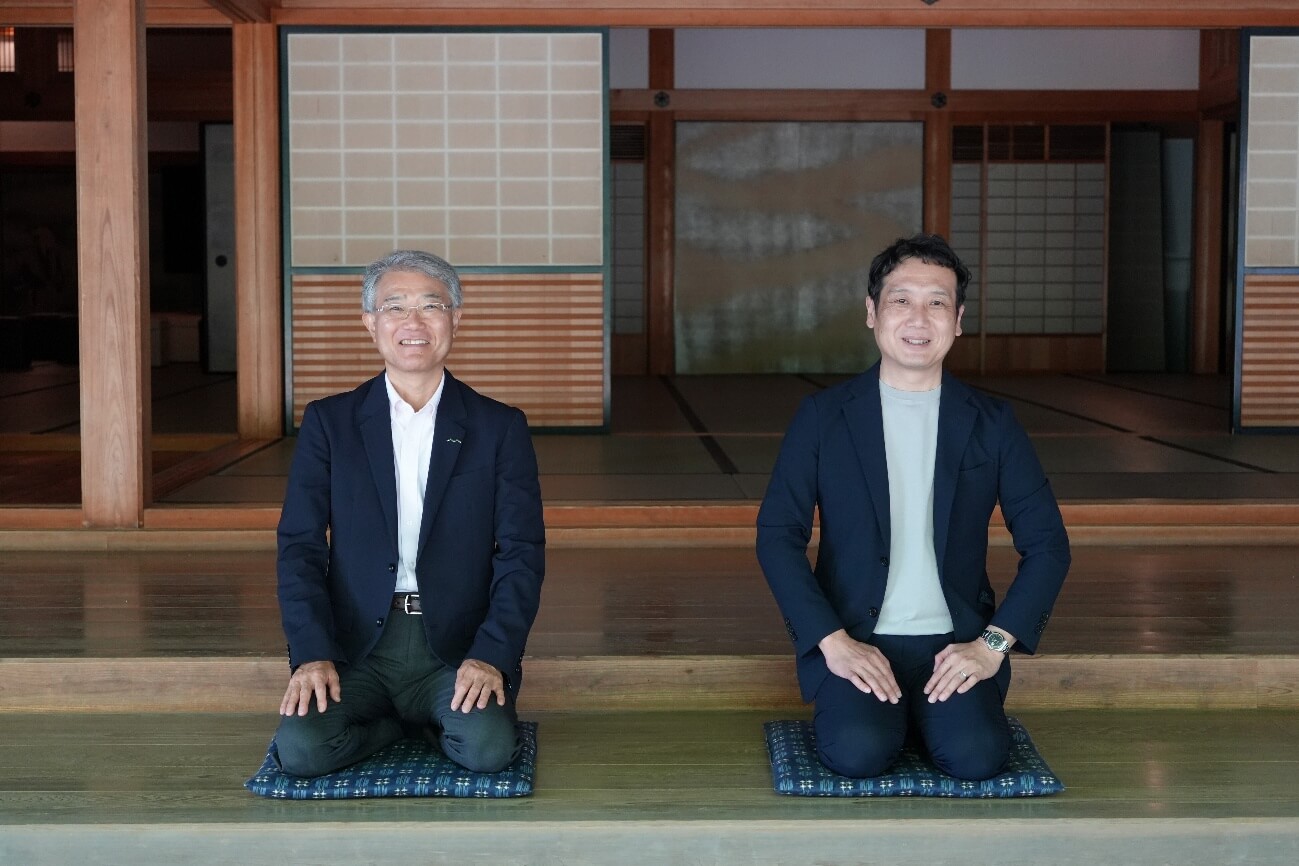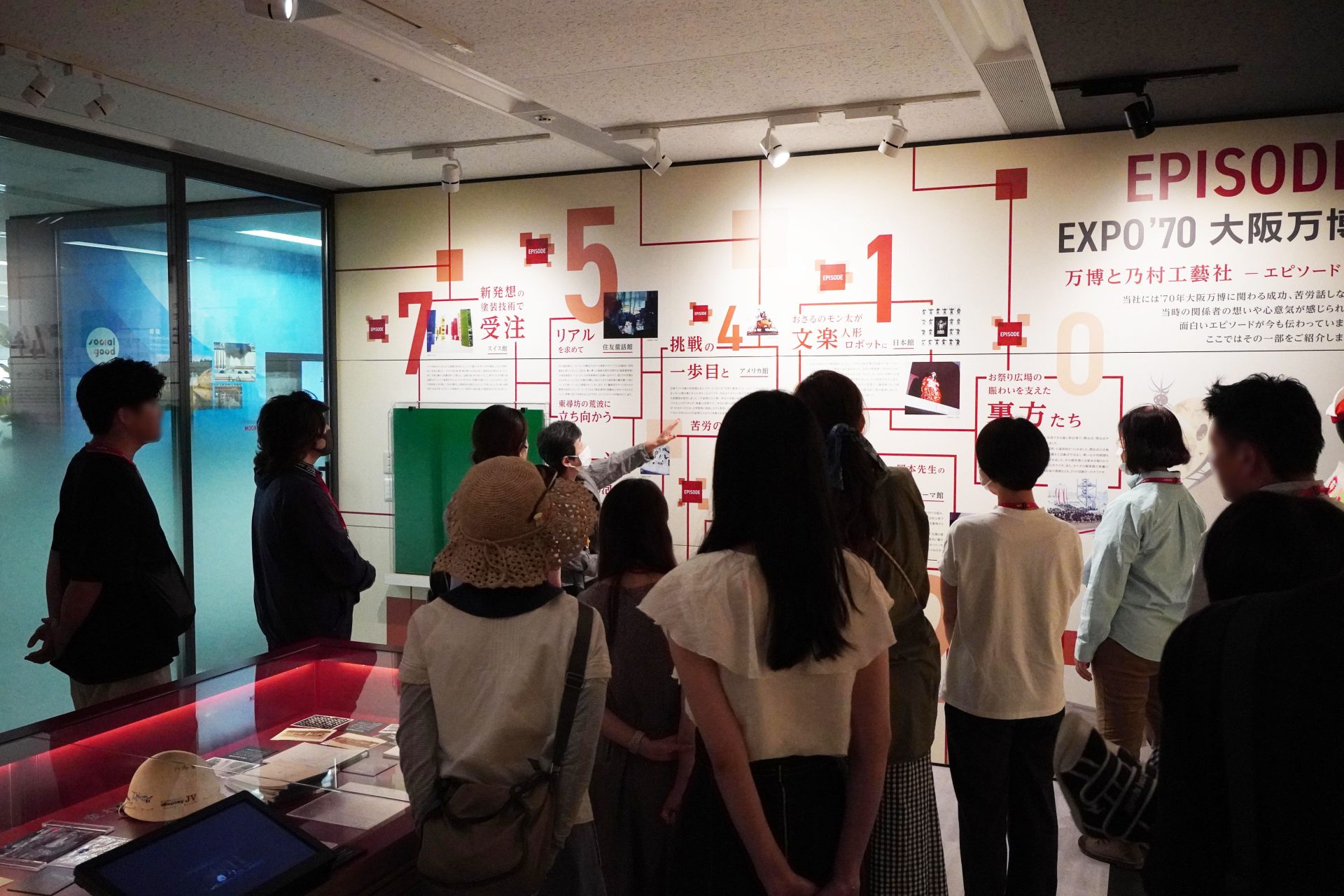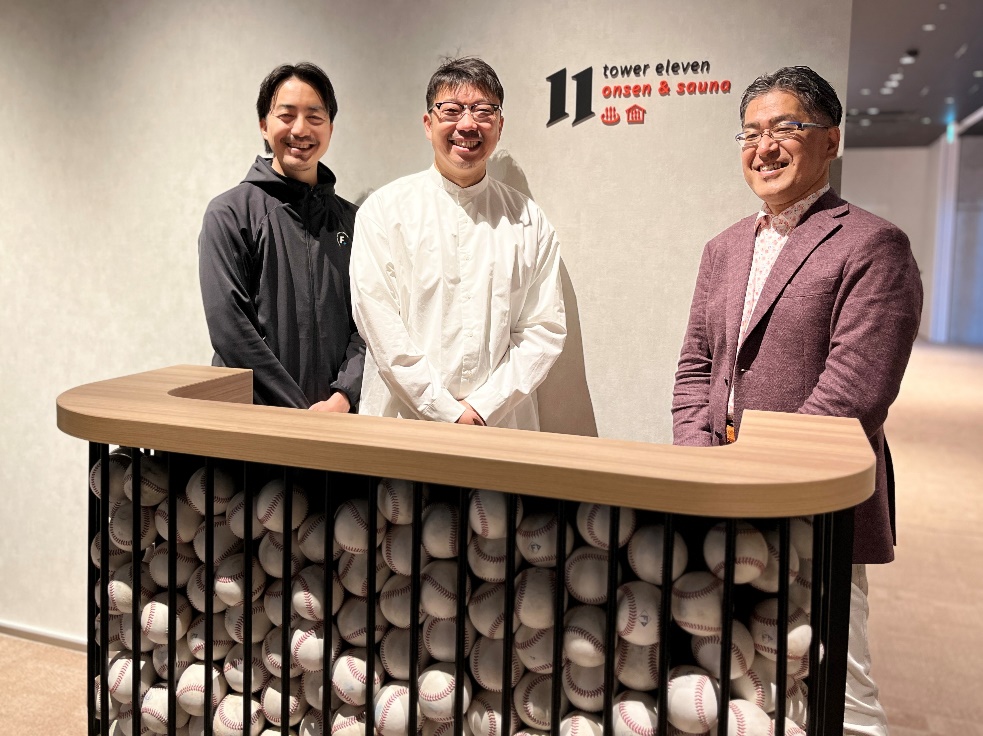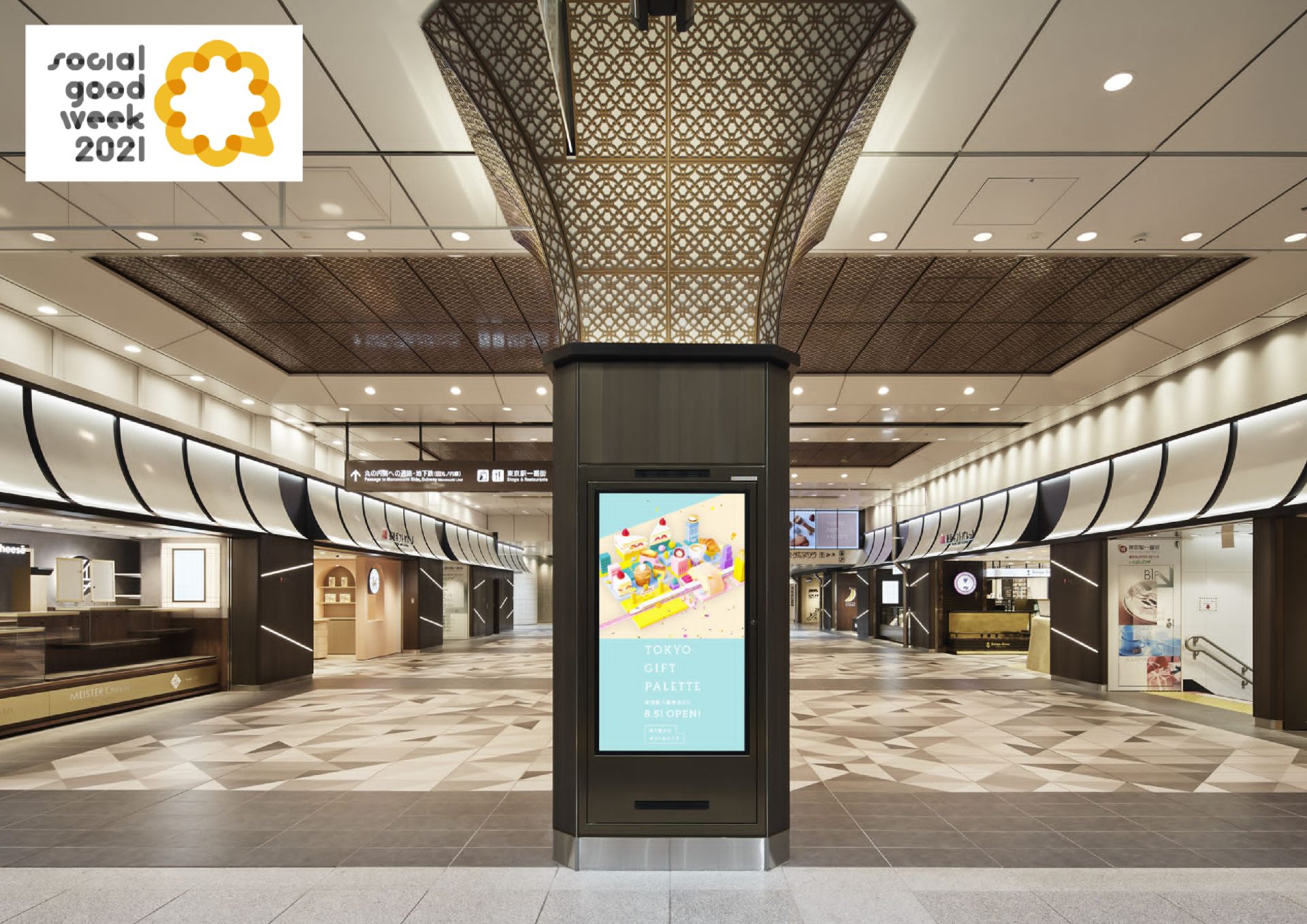
Tokaido Shinkansen Series 700 Reused at Tokyo Station Commercial Facility
2022/04/26- text and edit by
- nomlog editorial department

Aluminum used for retired Tokaido Shinkansen 700 series is reused for the walls and ceiling relief of "Tokyo Gift Palette", a specialty store area at the Yaesu North Exit of Tokyo Station. The use of recycled aluminum is not only evaluated from a sustainable perspective, but there is also a story that the Tokaido Shinkansen 700 series, which has been popular for a long time, has been reborn and reappeared in front of us. In this session, the project members of NOMURA Co., Ltd., who worked on the reuse, introduced the story, including the difficulties.
This article is a report article of the event "Social Good Week 2021" that introduces the "Social Good" projects of NOMURA GROUP.
* Click here for details on “Social Good”
NOMURA GROUP 's Social Good (Part 1 / Part 2)
* Click here for a list of report articles on “Social Good Week 2021”
Tokaido Shinkansen Series 700 Recycled Aluminum Project

Business Management Headquarters Sales Promotion Headquarters 4th Business Division Sales Department 2 Takashi Kobori
Joined in 2008.
In charge of project management for a wide range of operations, from commercial fields such as apparel, restaurants, and food sales, to offices, universities, and nursery schools.

Business Management Headquarters Sales Promotion Headquarters Cultural Environment Division Product Direction Department Takayuki Nishioka
Joined in 2009.
Achievements include JR Osaka Station improvement work, Aqua Hiroshima Bus Center 4th and 5th floor renewal work, NTT Credo Motomachi Building 10th floor environmental work, Okayama 1st Avenue food zone environmental work, cleanup showroom interior work, TDY Takamatsu showroom interior work, another Style interior construction, JAL Lounge Matsuyama Airport/Okayama Airport interior construction, etc.
Recycled Aluminum Project of “Reuse x Story”
Kobori
Today I would like to introduce a project to reuse the aluminum used in the body of the recently retired Tokaido Shinkansen 700 series as a building material for a commercial facility called "Tokyo Gift Palette" located near the ticket gates of the Yaesu North Exit of Tokyo Station. is.
"Tokyo Gift Palette" is a specialty store operated by Tokyo Station Development Co., Ltd., a group company of JR Tokai. It is conveniently located near the ticket gate and has an attractive tenant composition, so many people buy souvenirs and lunch boxes.
Let me talk a little bit about the Tokaido Shinkansen. The Tokaido Shinkansen Series 700 was launched in 1999 as the 4th generation Shinkansen, and has been nicknamed "Platypus". For about 20 years, this vehicle has supported Japan's aorta. This project is not just about the use of recycled materials, but also the story of the well-loved Tokaido Shinkansen Series 700 ending its role and starting a second life in a commercial facility at Tokyo Station.
 Left: Retired Tokaido Shinkansen Series 700 (provided by JR Tokai) / Right: Tokyo Gift Palette made from recycled Tokaido Shinkansen Series 700 aluminum
Left: Retired Tokaido Shinkansen Series 700 (provided by JR Tokai) / Right: Tokyo Gift Palette made from recycled Tokaido Shinkansen Series 700 aluminum
When NOMURA Co., Ltd. participated in this project, the perspective had already been completed, and the mission was to use recycled aluminum as a building material according to the perspective.
 Recycled aluminum is used for the parts colored in yellow, blue, and red in the perspective (left)
Recycled aluminum is used for the parts colored in yellow, blue, and red in the perspective (left)
Aluminum has excellent characteristics as a recycled material. The raw material for aluminum is the ore called bauxite, and the process of making new aluminum ingots from bauxite requires a huge amount of electricity. On the other hand, when melting aluminum cans and other aluminum products to make recycled ingots, it is said that only about 3% of the electricity required to make new ingots is required.
Revitalization of the Shinkansen car body, which has a high hurdle
However, although 6000 series aluminum alloys are mainly used for the body, roof, and sides of the Tokaido Shinkansen 700 series, there are deposits such as insulation and soundproofing materials, bolts, and many layers of paint. cannot be played as is. In the past, it was difficult to remove these deposits, so it was used as a deoxidizer necessary when melting iron. The first hurdle was how to remove these deposits when recycling Shinkansen bodies as "Shinkansen recycled aluminum."

Tokyo Station Development Co., Ltd. had already been researching how to remove deposits, and through various investigations and trial-and-error, they found a way to remove deposits by devising the scrapping process. The establishment of this deposit removal method was a major step towards the realization of the use of recycled aluminum for Shinkansen bullet trains. Debris is removed from the aluminum material removed from the Shinkansen car body and melted in a blast furnace to create a rod-shaped aluminum material called a billet.
The process up to this point was led by JR Tokai group companies, Tokyo Station Development, SUS Corporation, and Sangyo Shinko Co., Ltd. The next step is to materialize the design in Perth from this billet. From this stage, NOMURA Co., Ltd. participated in the project. When I first joined the project, I thought that we would be able to proceed relatively smoothly since we had already developed so far, but it was not so easy.
 Billet as a raw material for aluminum building materials
Billet as a raw material for aluminum building materials
Problem after problem stands in the way
This recycled aluminum billet will be processed into walls, noren, and ceiling reliefs, and each requires a different processing method. In addition, various problems awaited other than processing technology.
First, I will explain the use of recycled aluminum for the walls. I was able to create the walls relatively smoothly compared to others. The wall surface was processed into a plate shape using a technique called "extrusion molding," in which heat is applied to the billet and high pressure is applied to pass it through a mold. SUS Co., Ltd., which produced the billet, specializes in extrusion molding, so we were able to process the billet directly into a recycled aluminum plate. Since it will be installed on the wall along the concourse with a lot of traffic, we applied a hard anodized finish with a thicker coating than the normal anodized finish to prevent scratches.


Well, I was able to clear the walls by extrusion molding, but the rest of the noren and the ceiling relief didn't go well. There is a limit to the width of the parts that can be produced by extrusion molding, and it is not possible to make large plates. In addition, it is not suitable for processing curved surfaces such as noren, so we consulted with various companies that handle noren and aluminum, but there was a problem that surfaced.
The first is the issue of lots. Larger companies were trying to improve the efficiency of their aluminum production lines. Also, the capacity of the furnace for melting aluminum was fixed, and we found that we needed a lot of several tens of tons.
Secondly, there is the issue of the distribution ratio of recycled aluminum. In order to appeal that Shinkansen recycled aluminum is used, we would like to increase the allocation rate of recycled aluminum as much as possible, but some companies we consulted replied that they could only allocate about 2%.
And the third is the issue of facilities. Many companies were worried that putting recycled Shinkansen aluminum in their smelting furnaces would cause problems. Also, when aluminum with different composition from the standard product is put into the furnace, it is necessary to wash the furnace first, then put the Shinkansen recycled aluminum into the furnace, and then wash the furnace again after production. . Originally, recycled aluminum for Shinkansen bullet trains is a high-purity, excellent aluminum material, but it was difficult to find a company willing to accept the uncertain risk, and only time passed.
Finding a way out in traditional Japanese techniques
Under such circumstances, a company with traditional Japanese techniques for the production of noren appeared as a savior. This is Kanai Kogei Foundry in Uji, Kyoto, which uses a technique called "casting" to create ornaments and Buddhist statues used in shrines and temples. I visited the factory many times and conveyed my passion for recycled aluminum for Shinkansen bullet trains, and in the end they agreed to cooperate with us.
"Casting" is a method of making parts by first making a wooden pattern, then making a sand mold based on that wooden pattern, and pouring molten aluminum into it. The aluminum member is completed just like the wooden pattern that was made. I went to the site many times with the designer to check the wood pattern, and while discussing with the craftsman how to make it look lighter, after a lot of trial and error, I solved it by thinning the tip.
Shinkansen recycled aluminum is very hard, so there was a possibility that the melted aluminum would not flow into the sand mold, so it is melted together with other aluminum materials. Regarding the recycled aluminum allocation ratio, the factory initially said it would be about 20%, but after many discussions, we were able to increase it to 50%. 180 noren were produced using this method. I felt that by earnestly conveying my strong desire to "do something", the number of people who would agree with me would increase.

Apply processing technology for 1-yen coins and kitchenware
The last is a relief. A thin aluminum plate embossed with a double cherry blossom design was required for the top of the pillar winding and the ceiling. It turned out that a method called "rolling" was necessary for this production, so I searched for a company that could cooperate, and found a 1-yen coin (strictly speaking, the engraving is done by the Mint, so it is a 1-yen coin. It was Akao Aluminum Co., Ltd. in Nerima, Tokyo, which manufactures kitchenware such as kettles, aluminum bats, and trays using "rolling" technology.
In the "rolling" process, a billet of recycled Shinkansen aluminum and an aluminum bar before processing are first mixed and melted to create a block-shaped material called a slab. It is gradually extended thinly to produce an aluminum plate. This time, I made a thin board with a thickness of 3 mm, hollowed out the double cherry blossom design with a laser cut, and painted it. Again, I visited the site many times with the designer, and proceeded with the work while discussing how to create a three-dimensional effect and how to achieve a glossy finish with paint.
In this way, this project was completed using the three aluminum processing technologies of "extrusion", "casting" and "rolling". In a nutshell, "Utilization of Shinkansen recycled aluminum", in order to realize it, it was necessary to have various Japanese technologies and passion for manufacturing by each company.

Verification of ensuring safety
In this way, we were able to successfully produce building materials from recycled Shinkansen aluminum. The next step was a safety check. The location where the facility will be built faces the passageway where many people move every day, and ensuring safety has become the most important issue. Therefore, we created a 1/1 mock-up at NOMURA Co., Ltd. Kogyo's Shinkiba Training Center and invited the relevant parties to check the safety and quality. At the same time, we will conduct a thorough inspection of the factory where the building materials are produced, check for any dangerous areas, and check for any problems with the finishing quality in cooperation with the client and the design company, and will open safely in August 2020. is ready.

A space where people's feelings for the Tokaido Shinkansen 700 series live
I explained the outline, but Nishioka will talk about the viewpoint of the production side.

Nishioka
What I felt most through this project was the difficulty of handling aluminum as a material. The aluminum alloy used for the 700 series Tokaido Shinkansen is of the 6000 series, which is extremely rigid and suitable for extrusion, but not suitable for casting or rolling. . At first, we tried and tried to find a way to make the noren and ceiling reliefs using extrusion molding, but we had to change our mindset because of the design limitations of extrusion molding. Therefore, we worked on casting and rolling methods, but this method requires melting the Shinkansen recycled aluminum once. At that time, there was no data as it was the first time to try to increase the fluidity by melting, so we repeatedly verified it in the form of a demonstration experiment. With the full cooperation of Kanai Industrial Foundry and Akao Aluminum Co., Ltd., who actually produced the building materials, we increased the allocation rate as much as possible in a limited time, and achieved 50% for casting and 50% for rolling. We were able to make it 20%.
Another major technical challenge was the difficulty of welding, which is a characteristic of aluminum. Since the construction site is in the JR station premises, there are restrictions on work using firearms. Aluminum itself is a difficult material to weld. Further design consideration is also required. One of the hardest parts of this project was to consider the fit and construction method that would minimize the amount of welding work on site while ensuring the design of each piece.
Also, although it went well, in this project, there were many issues such as budget, schedule, quality, safety, etc. in addition to technical aspects. However, in any situation, we will focus on Tokyo Station Development Co., Ltd., the ordering party, CMYK Co., Ltd., the designer, NOMURA Co., Ltd., Ltd. and JR-related construction companies, which are the contractors, and many cooperating companies surrounding them. However, I think that understanding the significance of this project and always working on the same direction to solve problems was a major decisive factor for success.

Kobori
Last but not least, NOMURA Co., Ltd. participated in the Tokaido Shinkansen series 700 Last Run event held in March 2020 as an assistant to the organizer. Recycled Shinkansen aluminum was also used at this event, and customers who boarded the Last Run were presented with medals made from recycled Shinkansen aluminum. In addition, a nameplate was created from recycled Shinkansen aluminum and signed by customers who boarded the last run. These nameplates are installed at six locations within the Tokyo Gift Palette facility. At this event, we were able to hear the voices of our customers directly, and through this event, we once again felt that the Tokaido Shinkansen Series 700 is loved by many people and remains in their hearts. In addition to using recycled materials, I strongly believe that adding the narrative added value of the Tokaido Shinkansen Series 700 into the space and creating a space with a narrative is one of the social good ways that NOMURA Co., Ltd. can do. felt.
 JR Nagoya Takashimaya branch of The Body Shop, which uses recycled Shinkansen aluminum for part of its interior
JR Nagoya Takashimaya branch of The Body Shop, which uses recycled Shinkansen aluminum for part of its interior
*1 Title of invention: Recycling method for aluminum railway vehicles Patent applicant: Tokyo Station Development Co., Ltd. Patent application number: 2019-186881 Patent certification date: October 20, 2020
*2 Japan Aluminum Association Received the 2019 Japan Aluminum Association Award for Development
*3 GOOD DESIGN AWARD 2021 winner
The Tokaido Shinkansen Series 700, which has been loved by many people, will be reborn in a new form at a commercial facility. Thanks to this story and the passion of the people in charge who empathize with it, the number of people who have overcome difficulties that are not easy to deal with one after another has increased, and the process also has various stories. It was an introduction. There are times when we run into problems when it comes to regeneration and reuse, but stories and enthusiasm that stir emotions, not just logic, may create unprecedented cases. nomlog will continue to deliver such behind-the-scenes stories (nomlog editorial department)
Text: Sho Iwasaki/Photo: Yui Yasuda
Like this article?

